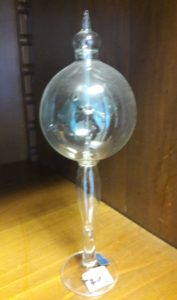
IT – Il radiometro, inventato nel 1873 dal fisico inglese William Crookes, è costituito da un bulbo di vetro da cui l’aria è stata in gran parte rimossa, per formare un vuoto parziale. Esso fornisce una dimostrazione indiretta della teoria cinetica dei gas. All’interno del bulbo, su una sede a basso attrito, si trova un rotore con alcune piastrine di metallo leggero poste in verticale: le piastrine sono lucidate a specchio su un lato e nere sull’altro. Se esposto alla luce del sole, luce artificiale o radiazioni infrarosse, le piastrine cominciano a ruotare senza nessun apparente motore che le spinga, in modo che il nero segua il lucido. Questo è dovuto al fatto che nell’ampolla vi è una minima quantità di gas residuo e sono proprio queste poche particelle di gas che rimbalzano sulla faccia nera, la quale essendo più calda di quella lucida le fa rinculare con maggior forza che sulla faccia lucida.
GB – Crookes radiometer – The radiometer, invented in 1873 by the English physicist William Crookes, consisted of a glass bulb from which the air was largely removed, to form a partial vacuum. It provided an indirect demonstration of the kinetic theory of gases. Inside the bulb, on a low friction base, there is a rotor with some light metal plates placed vertically. The plates are polished like mirrors on one side and black on the other. If exposed to sunlight, artificial light or infrared radiation, the plates begin to rotate without any apparent motor pushing them, so that the black sides follow the reflective sides. This is because inside the ampoule there is a minimal amount of residual gas and it is these few gas particles that bounce off the black face, which, being warmer than the shiny one, makes the particles recoil with more force than on the shiny face.